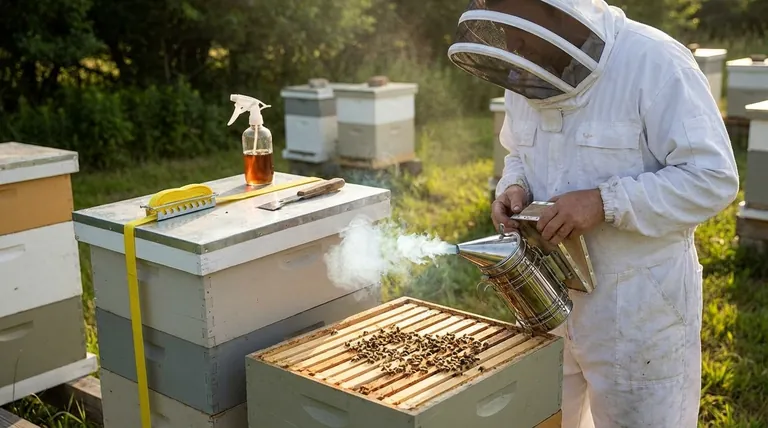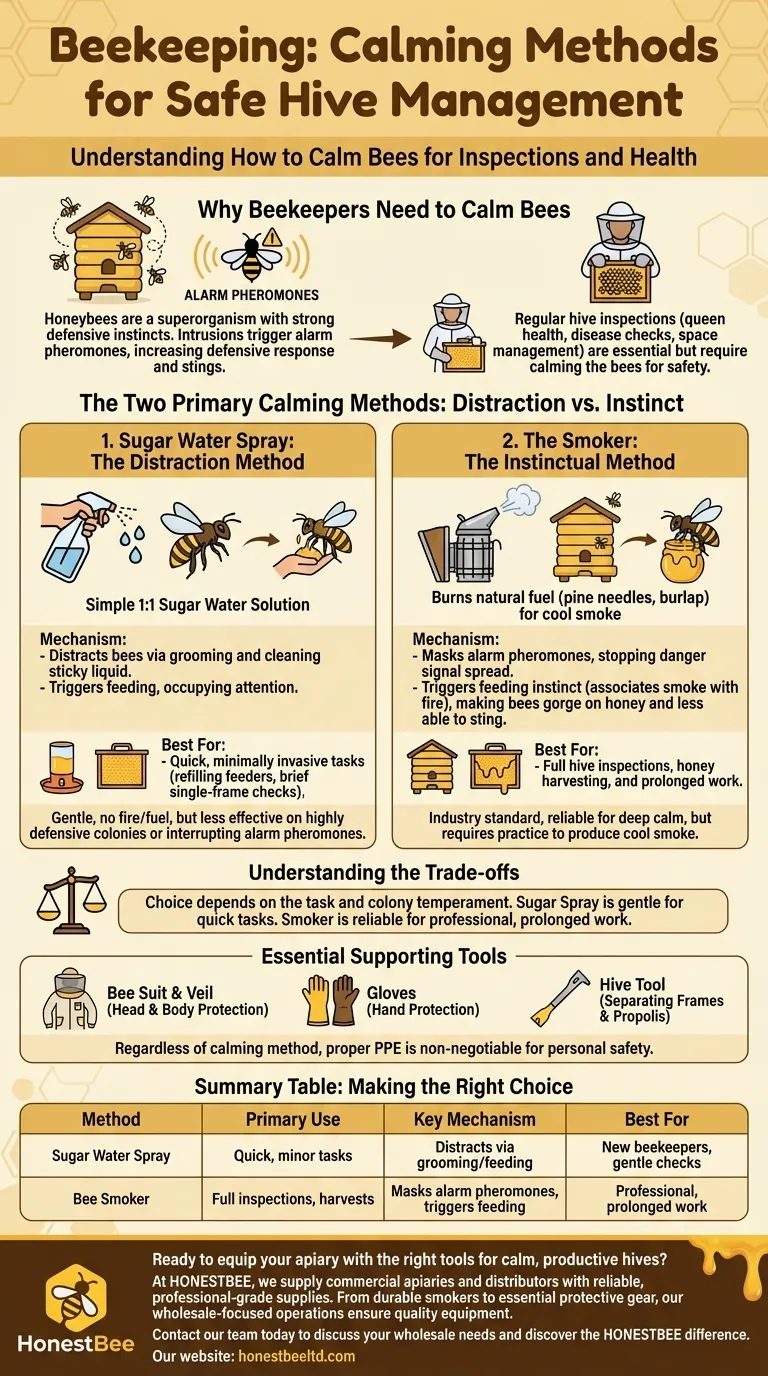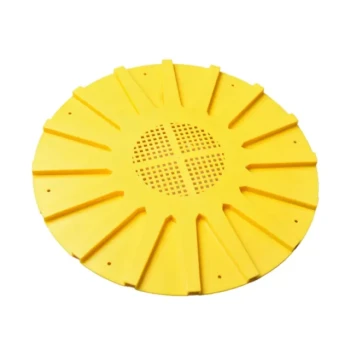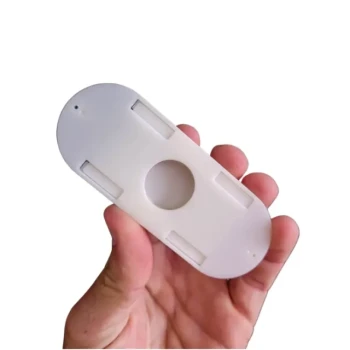The spray beekeepers sometimes use is a simple sugar water solution. This mixture serves as a gentle method to calm honeybees by distracting them. When sprayed, it coats their bodies and wings, triggering their natural instinct to stop, clean themselves, and consume the sweet liquid, taking their attention away from the beekeeper's presence.
While sugar water spray is an effective tool for distraction, the primary and most reliable method used by beekeepers to calm a hive is smoke from a bee smoker, which works by masking alarm pheromones and triggering the bees' instinct to prepare for a potential emergency.

Why Beekeepers Need to Calm Bees
A honeybee colony is a highly organized superorganism with strong defensive instincts. Any intrusion into the hive is perceived as a potential threat.
The Role of Alarm Pheromones
When a bee feels threatened or stings, it releases alarm pheromones. These chemical signals alert other guard bees in the colony, triggering a coordinated defensive response and increasing the likelihood of more stings.
The Need for Hive Inspections
Beekeepers must regularly open and inspect their hives to check for the queen's health, look for signs of disease or pests, and manage space for honey storage and brood rearing. Calming the bees makes this essential work possible and safer for both the beekeeper and the bees.
The Two Primary Calming Methods
Beekeepers primarily rely on two different tools that leverage bee behavior in distinct ways: distraction and instinct.
Sugar Water Spray: The Distraction Method
A spray bottle filled with a 1:1 mixture of sugar and water is a common tool, especially for new beekeepers or for quick tasks.
Its effectiveness comes from two bee behaviors. First, the bees will immediately begin to groom themselves and each other to clean off the sticky liquid. Second, they will consume the sugar, which further occupies their attention.
The Smoker: The Instinctual Method
The bee smoker is the iconic and most widely used tool for pacifying a colony. It's a small, handheld device that burns natural fuel (like pine needles or burlap) to produce a cool, thick smoke.
Smoke works on a much deeper, instinctual level. It masks the alarm pheromones, preventing the chemical danger signal from spreading throughout the hive. It also triggers a feeding response; bees associate smoke with a potential forest fire, and their instinct is to gorge on honey in case they need to abandon their hive. A bee with a full stomach is physically less able to flex its abdomen to sting and is generally more docile.
Understanding the Trade-offs
Neither method is universally perfect; the choice often depends on the task and the temperament of the colony.
When to Use Sugar Spray
Sugar spray is an excellent choice for quick, minimally invasive tasks. This includes refilling a feeder or performing a very brief inspection of a single frame.
It is gentle and doesn't require any fire or fuel. However, it can be less effective on highly defensive or agitated ("hot") colonies and does not interrupt the spread of alarm pheromones if a bee does become defensive.
When to Use a Smoker
A smoker is the industry standard for full hive inspections, honey harvesting, or any work lasting more than a few minutes.
Its ability to interrupt chemical communication makes it far more reliable for keeping an entire colony calm during a major disturbance. The primary drawback is that it requires practice to use correctly—the goal is to produce cool, white smoke, not hot air or flames.
Essential Supporting Tools
Regardless of the calming method used, proper personal protective equipment is non-negotiable.
This includes a bee suit or jacket with a veil to protect the head and body, and gloves to protect the hands. Beekeepers also rely on a hive tool, a specialized steel pry bar used to separate frames and boxes sealed by the bees with a sticky resin called propolis.
Making the Right Choice for Your Goal
Your approach should be dictated by the specific work you need to accomplish inside the hive.
- If your primary focus is a quick, gentle check: Sugar water spray is often sufficient and less disruptive to the colony.
- If your primary focus is a deep inspection or honey harvest: A properly used smoker is the more reliable and effective professional tool for maintaining calm.
- If your primary focus is personal safety: Always combine your chosen calming method with full protective gear, including a veil, jacket, and gloves.
Ultimately, effective beekeeping is about understanding and responding to the natural behavior of your bees.
Summary Table:
| Method | Primary Use | Key Mechanism | Best For |
|---|---|---|---|
| Sugar Water Spray | Quick, minor tasks | Distracts bees via grooming/feeding | New beekeepers, gentle checks |
| Bee Smoker | Full inspections, harvests | Masks alarm pheromones, triggers feeding instinct | Professional, prolonged work |
Ready to equip your apiary with the right tools for calm, productive hives?
At HONESTBEE, we supply commercial apiaries and equipment distributors with the reliable, professional-grade supplies needed for effective hive management. From durable smokers to essential protective gear, our wholesale-focused operations ensure you get the quality equipment your beekeeping business depends on.
Contact our team today to discuss your wholesale needs and discover the HONESTBEE difference.
Visual Guide

Related Products
- Professional Galvanized Hive Strap with Secure Locking Buckle for Beekeeping
- Wooden Queen Bee Excluder for Beekeeping
- High Performance Plastic Queen Excluder for Beekeeping and Apiary Management
- Brown Nicot Queen Cell Cups for Breeding Queen Bees Beekeeping
- Nicot Queen Rearing Kit for Beekeeping and Grafting in Nicot System
People Also Ask
- What is the best length for straps used around beehives? Why 12 Feet is the Industry Standard
- What are hive straps and why are they used? Secure Your Hives Against Wind, Predators, and Transport
- What is the advantage of using cam buckle straps? Secure Your Load Fast with Simple, Safe Tensioning
- What are the two styles of hive straps? Choose the Right Strap for Your Hive Security
- What maintenance is required for hive straps? A Guide to Cam Buckle vs. Ratchet Strap Care



















